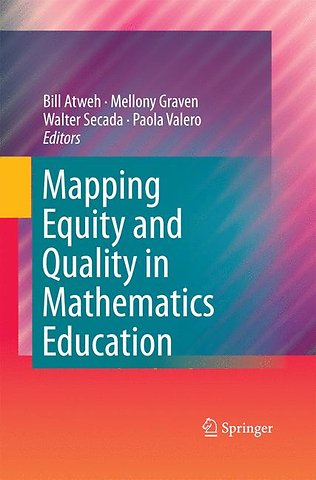Mapping Equity and Quality in Mathematics Education
Samenvatting
Concerns about quality mathematics education are often posed in terms of the types of mathematics that are worthwhile and valuable for both the student and society in general, and about how to best support students so that they can develop this mathematics. Concerns about equity are about who is excluded from the opportunity to develop quality mathematics within our current practices and systems, and about how to remove social barriers that systematically disadvantage those students. This collection of chapters summarises our learning about the achievement of both equity and quality agendas in mathematics education and to move forward the debate on their importance for the field.
Specificaties
Inhoudsopgave
Dedication
Preface
Part 1
The Theoretical Landscape
Chapter 1.1
Disrupting Development as the Quality / Equity Discourse: Cyborgs and Subalterns in School Technoscience
Anna Chronaki
Chapter 1.2
Beyond Gap Gazing: How can Thinking about Education Comprehensively Help Us Re(envision) Mathematics Education?
Rochelle Gutierrez and Ezekiel Dixon –Roman
Chapter 1.3.
Beyond Disavowing the Politics of Equity and Quality in Mathematics Education
Alexandre Pais and Paola Valero
Chapter 1.4.
Does Every Child Count? Quality, Equity and Mathematics within Neoliberalism
Anna Llewellyn and Heather Mendick
Chapter 1.5
Quality and Equity in Mathematics Education as Ethical Issues
Bill Atweh
Chapter 1.6
Ghettoes in the Classroom and the Construction of Possibilities
Ole Skovsmose and Miriam Godoy Penteado
Chapter 1.7
Identity as the Cornerstone of Quality and Equitable Mathematical Experiences
Margaret Walshaw
Chapter 1.8
A Framework for Evaluating Quality and Equity in Post-Compulsory Mathematics Education
Gail E. FitzSimons
Chapter 1.9
Editor’s Reaction
The Theoretical Landscape
Walter G. Secada, University of Miami (editors reaction)
Part 2
Mapping Social Construction and Complexities
Chapter 2.1
Equity in Quality Mathematics Education: A Global Perspective
Murad Jurdak
Chapter 2.10
How Many Sides Does a Box Have? The Struggle to Respect Young People’s Thinking
Julian Weisglass
Chapter 2.11
‘Sometimes I think Wow I’m doing Further Mathematics…’: Balancing Tensions Between Aspiring and Belonging
Cathy Smith
Chapter 2.12
Editor’s Reaction
Mapping Social Constructions and Complexities
Paola Valero
Chapter 2.2
Effects of Student-Level and School-Level Characteristics on the Quality and Equity of Mathematics Achievement in the United States: Using Factor Analysis and Hierarchical Linear Models to Inform Education Policy
Mack C. Shelley and Wenyu Su
Chapter 2.3.
Equity and Quality Issues in Mathematics Education in Malawi schools
Mercy Kazima and Ch. Mussa
Chapter 2.4
Looking for Equity in Policy Recommendations for Instructional Quality
Enakshi Bose and J. Remillard
Chapter 2.5
Whose ‘Quality’ and ‘Equity’? The Case of Reforming 14-16 Mathematics Education in England
Andy Noyes
Chapter 2.6
Equity and Quality of Mathematics Education: Research and Media Portrayals
Helen J. Forgasz and Gilah C. Leder
Chapter 2.7
Equity Concerns About Mathematical Modelling
Eva Jablonka and Uwe Gellert
Chapter 2.8
Equity and the Quality of the Language used in Mathematics Education
Marcus Schütte, Gabriele Kaiser
Chapter 2.9
Foundational Mathematics: A Neglected Opportunity
Jennifer S. McCray and Jie-Qi Chen
Part 3
Landmarks of Concern
Chapter 3.1
Students with ‘Special Rights’ for Mathematics Education
Ann Gervasoni and Lena Lindenskov
Chapter 3.10.
What Does Quality Mean in the Context of White Institutional Space?
Danny Bernard Martin
Chapter 3.11
Part III
Editor’s Reaction
Landmarks of Concern
Mellony Graven
Chapter 3.2.
Females in Mathematics: Still on the Road to Parity
Lynda R. Wiest
Chapter 3.3.
Quality and Equity in Mathematics Education: A Swedish Perspective
Inger Wistedt & Manya Raman Sundström
Chapter 3.4.
Equity Issues Concerning Gifted Children in Mathematics: A Perspective From Mexico
Asuman Oktaç and Solange Roa Fuentes and Marco Antonio Rodríguez Andrade
Chapter 3.5.
Enhancing Quality and Equity in Mathematics Education for Australian Indigenous Students
Sharon Cooke, Peter Howard, Kevin Lowe and Bob Perry
Chapter 3.6.
Qualities of Respectful Positioning and their Connections to Quality Mathematics
Lisa Lunney Borden and David
Chapter 3.7
The Effects of Poverty and Language on Mathematics Achievement
for English Language Learners
Clara Lee Brown and Jo Ann Cady and Cheryl A. Lubinski
Chapter 3.8.
Toward a Framework of Principles for Ensuring Effective Mathematics Instruction for Bilingual Learners through Curricula
Kathleen Pitvorec, Craig Willey and Lena Khisty
Chapter 3.9
Reconceptualizing Quality and Equity
Roni Ellington and Glenda Prime
Part 4
No Highway and No Destination?
Chapter 4.1
The CERME Spirit: Issues of Quality and Inclusion in an Innovative Conference Style
Barbara Jaworski and Joao Pedro da Ponte
Chapter 4.10
Children’s Numerical Thinking in the Early School Grades and How to Foster and Understand its Development
Álvaro Buenrostro and Olimpia Figueras
Chapter 4.11
Part IV
Editor’s Reaction
No Highway and No Destination?
Bill Atweh
Chapter 4.2
Productive Pedagogies in the Mathematics Classroom: Case Studies of Quality and Equity
Martin Mills and Merrilyn Goos
Chapter 4.3.
Mathematical Literacy in South Africa: Increasing Access and Quality in Learners’ Mathematical Participation Both in and Beyond the Classroom
Mellony Graven and Esme Buytenhuys
Chapter 4.4.
Together-and-APart for Quality and Equity
In Mathematics Education
Liora Linchevski, Bilha Kutscher and Alwyn Olivier
Chapter 4.5.
Research from Practice: Using Technology to Provide Advanced Mathematics and Equity to High School Students in the United States
Benjamin Hedrick and Douglas Edwards
Chapter 4.6.
Parents And Teachers Collaborate To Achieve Equity And Quality In Mathematics: A Case Study
Virginia R. Nelson
Chapter 4.7.
Critical Mathematics in a Secondary Setting: Promise and Problems
Andrew Brantlinger
Chapter 4.8.
Mathematics Education: What is the Point?
Laura J. Jacobsen and Jean Mistele
Chapter 4.9.
Equity and Quality in a Mathematics Program for Under-Represented Students at an Elite Public University
Vilma Mesa and Robert Megginson
Anderen die dit kochten, kochten ook
Net verschenen
Rubrieken
- aanbestedingsrecht
- aansprakelijkheids- en verzekeringsrecht
- accountancy
- algemeen juridisch
- arbeidsrecht
- bank- en effectenrecht
- bestuursrecht
- bouwrecht
- burgerlijk recht en procesrecht
- europees-internationaal recht
- fiscaal recht
- gezondheidsrecht
- insolventierecht
- intellectuele eigendom en ict-recht
- management
- mens en maatschappij
- milieu- en omgevingsrecht
- notarieel recht
- ondernemingsrecht
- pensioenrecht
- personen- en familierecht
- sociale zekerheidsrecht
- staatsrecht
- strafrecht en criminologie
- vastgoed- en huurrecht
- vreemdelingenrecht






